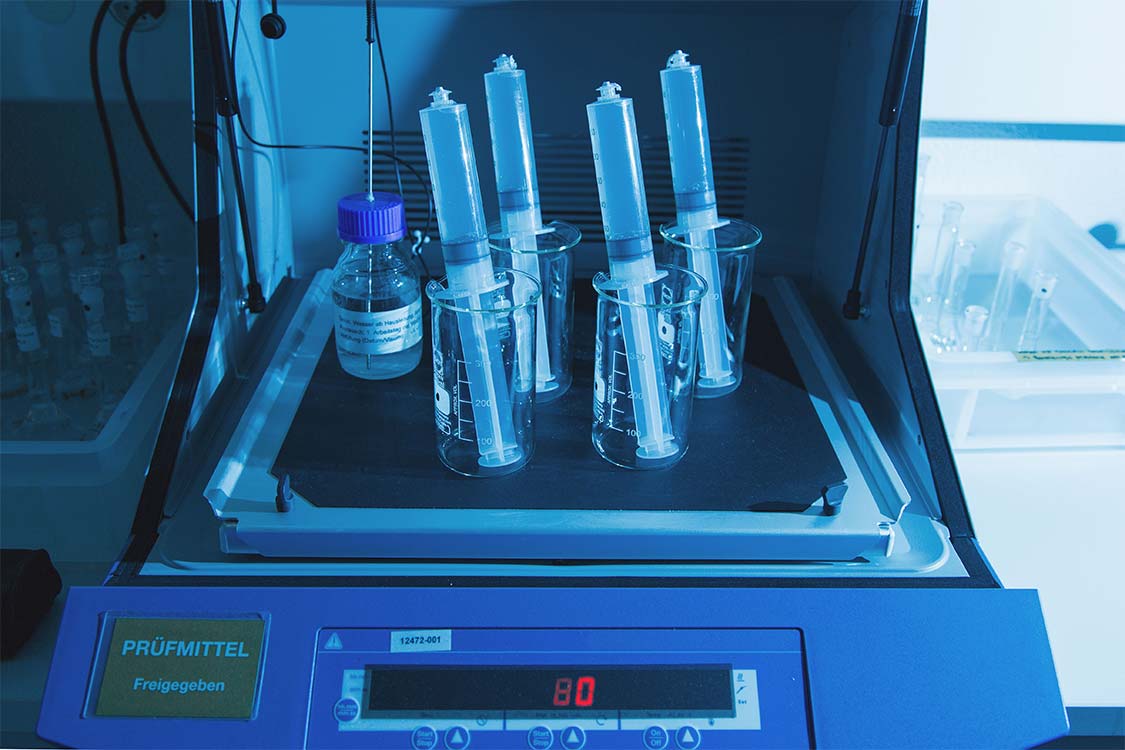Share article
Share this article on your favorite social media channel.
Reliable quality control of medical devices is a precondition for production in accordance with international standards and for successful product marketing. EN ISO 10993-7 regulates the quality control of these medical devices.
A new version of the EN ISO 10993-7 standard has been in force since October 2008 and contains important changes to allowable limits.
Manufacturers of medical devices are obliged to perform analytical tests on residue from sterilisation procedures in accordance with international standards. The task of analytics is to establish whether the prescribed limits are being adhered to.
The essential changes refer to allowable limits for ethylene oxide and ethylene chlorohydrin. New specifications have been issued for various special products. The revised standard also provides information on tolerable doses for products that come into contact with body surface areas. A wide range of special cases are also explicitly regulated.
The following table provides an overview of changes to allowable limits:
| Revision 1995 | Revision 2008 |
| Permanent contact devices | |
| ETO: 0.1mg average daily dose | ETO: 0.1mg average daily dose |
| ETO: 20mg in the first 24h | ETO: 4mg in the first 24h |
| ETO: 60mg in the first 30 days | ETO: 60mg in the first 30 days |
| ETO: 2.5g in a life-time | ETO: 2.5g in a life-time |
| ECH: 2mg average daily dose | ECH: 0.4mg average daily dose |
| ECH: 12mg in the first 24h | ECH: 9mg in the first 24h |
| ECH: 60mg in the first 30 days | ECH: 60mg in the first 30 days |
| ECH: 50g in a life-time | ECH: 10g in a life-time |
| Prolonged exposure devices | |
| ETO: 2mg average daily dose | ETO: 2mg average daily dose |
| ETO: 20mg in the first 24h | ETO: 4mg in the first 24h |
| ETO: 60mg in the first 30 days | ETO: 60mg in the first 30 days |
| ECH: 2mg average daily dose | ECH: 2mg average daily dose |
| ECH: 12mg in the first 24h | ECH: 9mg in the first 24h |
| ECH: 60mg in the first 30 days | ECH: 60mg in the first 30 days |
| Limited exposure devices | |
| ETO: 20mg average daily dose | ETO: 4mg average daily dose |
| ECH: 12mg average daily dose | ECH: 9mg average daily dose |
| Tolerable contact limits for surface contacting devic | |
| ETO: --- | ETO: 10 µg/cm2 |
| ECH: --- | ECH: 5 µg/cm2 |
| Special situations | |
| Intraocular lenses | |
| ETO: 0.5µg per lens per day | ETO: 0.5µg per lens per day |
| ETO: 1.25µg per lens | ETO: 1.25µg per lens |
| Blood cell separators (blood collection) | |
| ETO: 60mg average daily dose | ETO: 10 mg |
| ECH: --- | ECH: 22 mg |
| Blood oxygenators and blood separators | |
| ETO: 60mg average daily dose | ETO: 60 mg |
| ECH: --- | ECH: 45 mg |
| Devices for cardiopulmonary bypass procedures | |
| ETO: --- | ETO: 20 mg |
| ECH: --- | ECH: 9 mg |
| Extracorporeal blood purification devices | |
| ETO: diverse | ETO: 4.6 mg |
| ECH: diverse | ECH: 4.6 mg |
| ETO: allowable dose for a lifetime may be exceeded | ETO: allowable dose for a lifetime may be exceeded |
| ECH: allowable dose for a lifetime may be exceeded | ECH: allowable dose for a lifetime may be exceeded |
UFAG LABORATORIEN has optimised the analytical procedure to determine ethylene oxide residue in medical devices and, in addition to analytical services, also provides consultancy on this standard.
